
The Fatal Attraction of Adolf Hitler. A BBC Television Network Production, in association with the Arts and Entertainment Network, the Australian Broadcasting Corporation and Television New Zealand. Produced by Bill Treharne Jones; presented by Professor Christopher Andrew, University of Cambridge. London, 1989. Distributed in the United States by Films for the Humanities and Sciences.
This BBC documentary, made in 1989, seeks
to answer two related questions. How did Hitler, whose National Socialist
Party never gained the votes of much more than a third of the German electorate
in a free election, manage to win the support of the overwhelming majority of the German people? To what extent did they share his goals of the mass murder of the Jews and the establishment of a German Empire based on the conquest of the Soviet Union, the murder of the original inhabitants or their reduction to rightless slaves of the Third Reich?
It argues that most Germans came, after January 1933, to support Hitler because of their belief that he had brought to an end the hardships of the Great Depression and the humiliations which the country had suffered at Versailles. Having fallen prey to his "fatal attraction," they were prepared, even if in some cases unwillingly, to support him in his goals of eliminating the Jews and establishing a German Empire with a population of 200 million.
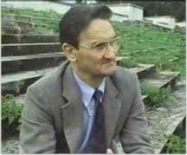 |
Alfons Heck.
From
The Fatal Attraction of Adolf Hitler.
|
|
28.8
| 56k
|
This "fatal attraction" explains the failure of German morale to crack under the devastating impact of Allied mass bombing in which 300,000 civilians died. Only after Hitler's suicide was the spell broken. In this sense, the film can be seen as directly contradicting the view set out recently by Daniel Goldhagen in his Hitler's Willing Executioners: Ordinary Germans and the Holocaust—that most Germans shared Hitler's genocidal ambitions vis-a-vis the Jews and were only too willing to carry them out.[1] The film sets out its position convincingly
and is certainly more persuasive than the one-dimensional stereotypes
which populate Goldhagen's book. It does perhaps underestimate the degree
of repression which characterized the Third Reich, which was a significant
factor in the support the regime enjoyed. But it brings out clearly the
fact, sometimes insufficiently stressed, that by 1936, probably over 90%
of the German people were, in some degree, supporters of the Nazi regime.
As Alfons Heck, a member of the Hitler Youth and one of those interviewed
in the film puts it, if Hitler had died in 1938, he would undoubtedly
have been remembered by most Germans as one of their greatest leaders.
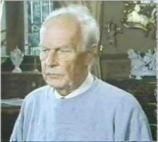 | Axel von der Busche. From The
Fatal Attraction of Adolf Hitler.
|
|
28.8
| 56k
|
The discussion of the decision to embark on the mass murder of the Jews is well handled. It is seen as part
of the radicalization of Nazi policy which accompanied Operation Barbarossa, although it may have been decided upon somewhat earlier, as there was inevitably a time-lag between its adoption and implementation, caused both by technical problems inherent in carrying it out and making sure it would achieve its objectives. It is also probably a vain quest to search for a single order from Hitler initiating the genocide, as Axel von der Busche, an officer on the Eastern Front and a member of the anti-Nazi resistance which carried out the assassination attempt of July 20, 1944 points out. This was not how the Fuehrer worked. In the words of a leading scholar of the problem, Christopher Browning, Hitler ordered, or to be more precise, incited or solicited the preparation of an extermination plan in the summer of 1941."[2]  |
German awareness of genocide.
From The Fatal Attraction of Adolf Hitler.
|
|
28.8
| 56k
|
One revelatory
insight into Hitler's thinking is provided by Henrietta von Schirach,
one of Hitler's oldest associates.
After witnessing
the deportation of Jews from Amsterdam, she brought herself to remonstrate
with Hitler about his policy of mass murder. Hitler told her that she
was too sentimental and that at a time when 10,000 young German men were
being killed every day on the battlefield, the biological balance was
being overturned and this meant that the Jews had to be eliminated. What
does emerge clearly from the film is the fact that a very large part of
the German people was implicated in the genocide if only as passive bystanders.
Axel von der Busche and Gunther Tredwindt, who was a school boy in Dusseldorf
in the late 1930s and during the war, give revealing accounts of how widely
the policy of mass murder was known.
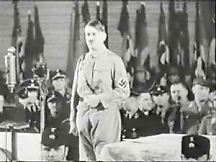 | Hitler's appeal. From
The Fatal Attraction of Adolf Hitler.
|
|
28.8
| 56k
|
The film is rather old-fashioned in format. It has a narrator, Professor Christopher Andrew of Cambridge University,
and is a combination of talking heads, archival footage, and contemporary film footage of a number of key sites—including Hitler's birthplace, Braunau; the doss-house in Vienna where he lived for three years before 1914; Berchtesgaden, Hitler's eastern headquarters; the "Wolf's Lair," his bunker; and the site of the Nazi rallies in Nuremburg.
There is also some striking footage of Auschwitz.
Most of the archival film clips are well-known, though there is some footage of the rallies
which accompanied the outbreak of war in 1914 in Munich,
of Hitler's early political activity in Munich and the unsuccessful putsch
in November 1923, and of
Lloyd George's visit to Berchtesgaden—which is both new and revelatory. Yet the film is
none the worse for its conventional character.
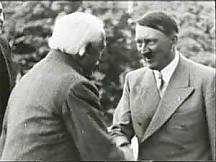 |
Hitler with Lloyd George.
From The Fatal Attraction of Adolf Hitler.
|
|
28.8
| 56k
|
Its serious, sober, and restrained
style is very suitable for the difficult problems which it seeks to address.
Hitler's extraordinary oratorical skill is constantly stressed and displayed,
while the interviews are well used to demonstrate Hitler's extraordinary
hold over the German people. The "talking heads" are indeed one of the strong
points of the film. They include, in addition to those already mentioned,
the historian and biographer of Hitler, Sir Alan Bullock; Sir Anthony
Eden; and Lloyd George's private secretary, Albert Sylvester. Among the
German talking heads are Hitler's original foreign press officer, Putzi
Hanfstaengel and his son Egon, Adolf Galland, a German fighter ace during
the World War II; Reinhard Spitzy, Ribbentrop's private secretary;
Major Freytag von Loringhoven of the German General Staff, who was with
Hitler in the last year in his Berlin bunker; Traudl Junger, who was Hitler's
secretary during the last year of the war; and Richard Weber, one of Hitler's
doctors. Emil Klein, who took part in the ill-fated Nazi protest march
in Munich of November 1923, and two "ordinary" Germans, Else Wendel, a
social worker in the Berlin slums of the 1930s, and Wilhelm Huebner, a
member of the Hitler Youth. All of them reveal different aspects of Hitler's
"fatal attraction" for the Germans.
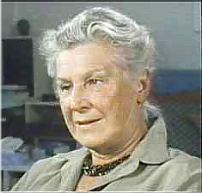 |
Traudl Junger.
From
The Fatal Attraction of Adolf Hitler.
|
|
28.8
| 56k
|
Particularly eloquent is the expression
of shame and regret at her support for the Fuehrer by Traudl Junger with
which the film ends.
There is one Jewish interviewee,
Yehoshua Rosenbaum, a member of a Sonderkommando in Auschwitz, who gives
a restrained but harrowing account of the process of gassing Jews.
At the same time, the fact that the film was made in 1989 does mean that it is somewhat outdated. Its long polemic with the views of Daniel Goldhagen loses from the fact that obviously Goldhagen is not mentioned in this discussion. The figure of two million Jews murdered in Auschwitz is no longer widely accepted in scholarly circles. According to the estimates of Franciszek Piper of the Auschwitz-Birkenau State Museum, in his article "Auschwitz. How Many Perished—Jews, Poles, Gypsies," at least 1.3 million persons were deported to Auschwitz.[3] They included approximately: 1.1 million Jews, 140,000-150,000 Poles, 23,000 Gypsies, 25,000 Soviet POWs, and 25,000 prisoners of other nationalities. Of these, about 1.1 million perished. The aggregate figures given by Piper are: 960,000 Jews, 70,000-75,000 Poles, 21,000 Gypsies, 15,000 Soviet POWs and 10,000-15,000 registered prisoners of other nationalities. These figures are probably about as close to the truth as we can approach. It is certainly distasteful to engage in scholarly controversies about the numbers of the victims of Nazism. But without rigorous scholarly accuracy in this area, all research into Nazi crimes is vulnerable to revisionist attack. Other outdated perspectives of the film are also the result of its age. Thus the view that the enduring division of Germany was one of the main consequences of Nazism needs to be updated. The film would also benefit from some discussion of the implications of the end of Communism for our understanding of the Nazi phenomenon. The film is also very anglocentric. The role of both Britain and the Soviet Union in the defeat of Hitler is stressed. Barely a word is said of the role of the United States.
The film should certainly prove a very valuable classroom aid and its basic format of a lecture with slides and film makes it very suitable for educational use. Its length (90 minutes) does create some problems for classroom use in the US, though it can easily be shown in two halves. I will certainly want to use it in my own course on "The Destruction of European Jewry."
Antony Polonsky
US Holocaust Memorial Museum and Brandeis University
NOTES:
-
Daniel Goldhagen, Hitler's Willing Executioners: Ordinary Germans and the Holocaust (New York, 1996). [Return]
- Christopher R. Browining, "A Reply to Martin Broszat Regarding the Origins of the Final Solution," Simon Wiesenthal Centre Annual 1 (1984): 114. [Return]
- Franciszek Piper, "Auschwitz. How Many Perished—Jews, Poles, Gypsies." Yad Vashem Studies, 21 (1991). [Return]
~ End ~
Video Review of The Fatal Attraction of Adolf Hitler.
Copyright
© 1999 by The Journal for MultiMedia History
Comments
| JMMH
Contents
|





